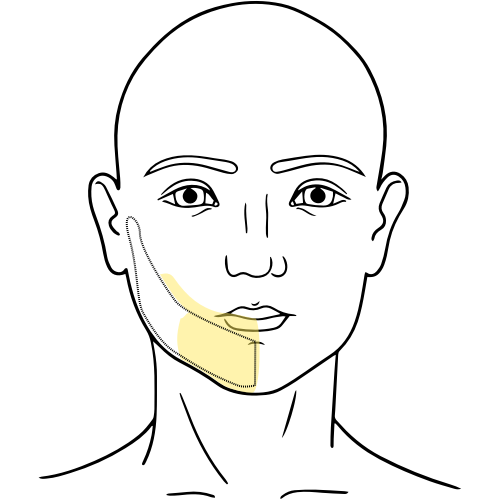Distribution
- Mandibular teeth (excluding buccal gingiva of mandibular molars)
- Lower lip, chin and tongue
Indications
- Dental pain (caries, dry socket, abscess)
- Fractures (mandibular, alveolar ridge, dental)
- Lingual lacerations
Contraindications
- Infection over site
- Allergy to local anesthetic
Equipment
- 2-5cc of local anesthetic of choice
- 5cc topical anesthetic (lidocaine-soaked gauze, swishing viscous lidocaine)
- Syringe
- Cleansing solution
- 1.5 inch small gauge needle (25 or greater)
Preparation
Landmarks

Positioning
- Patient should be sitting upright such that the mandible is parallel to the floor with the mouth open.
- Place yourself on the opposite side of the site being injected.
Technique
- Palpate the retromolar fossa with your non-injection thumb.
- Place the index finger of the same hand externally over the ramus of the mandible retracting the tissues toward the buccal aspect
- Place the index finger of the same hand externally over the ramus of the mandible retracting the tissues toward the buccal aspect
- Visualize the pterygomandibular triangle
- Hold the syringe parallel to the occlusal surfaces of the teeth and angle so that the barrel lies between the 1st/2nd premolars of the opposite side
- If a large syringe is being used, consider bending the needle 30 degrees for this approach
- Puncture with the needle 1cm above the occlusal surface of the molars
- Advance the needle until bone is felt
- Inject 1-2cc
- Injecting as your withdraw has the added benefit of including the lingual (ant 2/3 of the tongue)
Complications
- Inadvertent injection of the parotid gland (may cause iatrogenic Bell’s Palsy). Occurs when bone is not felt during the initial approach. Redirect needle anteriorly until bone is felt
- Carotid sheath injection (Horner’s from stellate ganglion blockade)
- Carotid artery puncture
- If the needle enters too low (at the level of the teeth), the anesthetic will be deposited over the bony canal that house the mandibular nerve and not over the nerve itself
